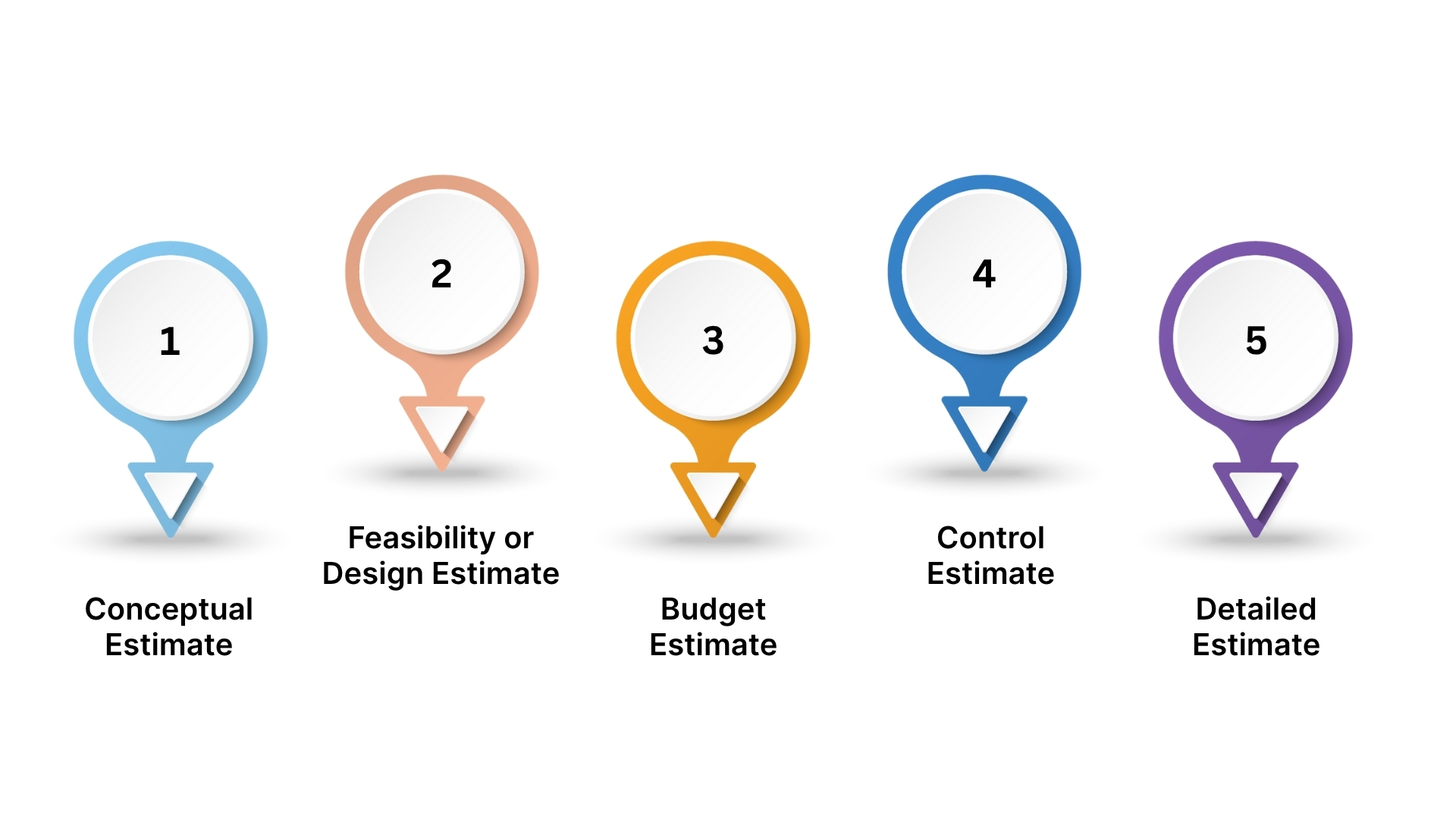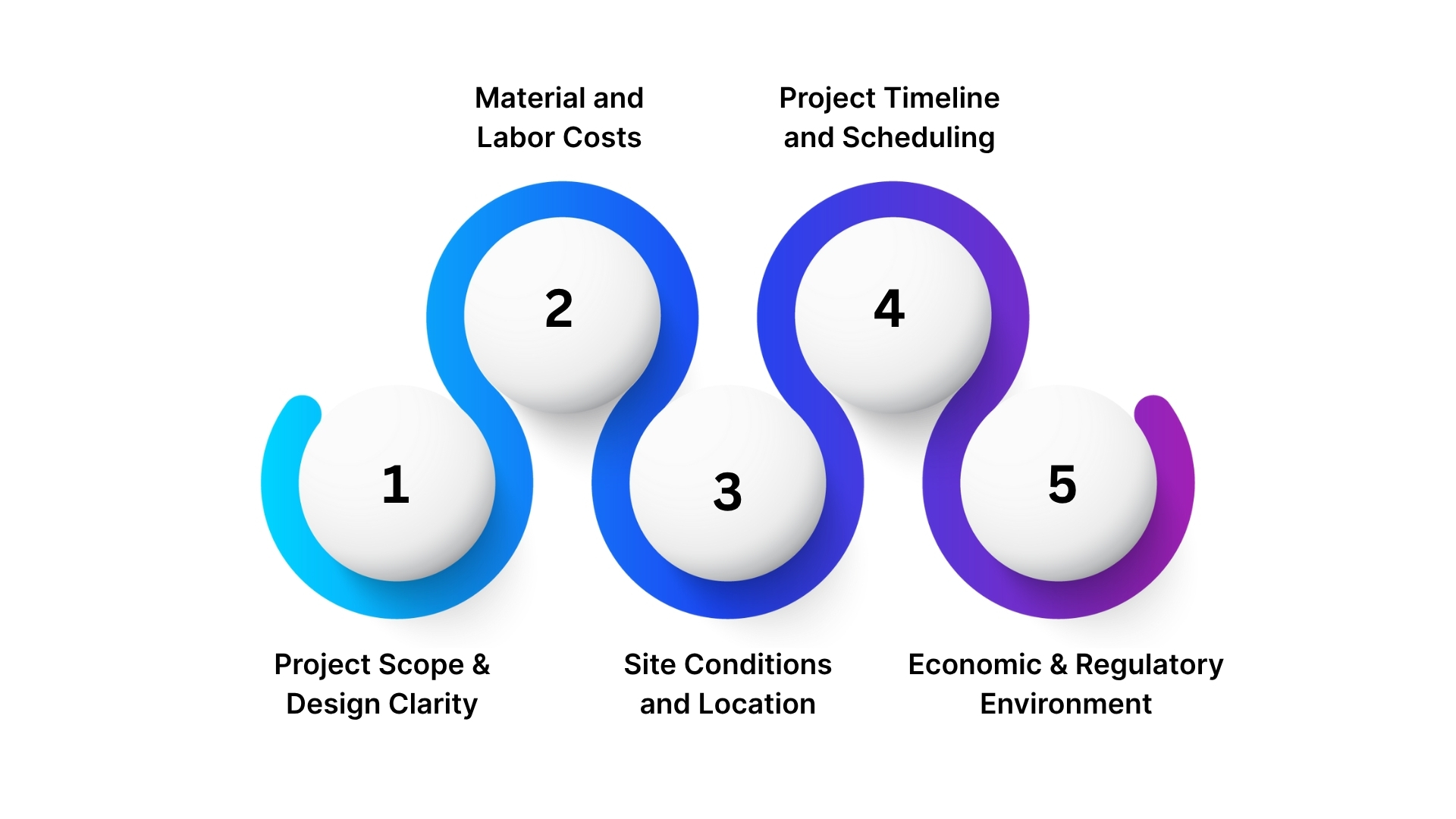
In construction, one wrong estimate can erase profits in a heartbeat. A single miscalculated line item, labour hours, material costs, or equipment rates, can turn a promising project into a financial setback. And in Saudi Arabia’s booming construction market under Vision 2030, where projects worth over 1.3 trillion ( SAR 4.9 trillion) are underway and construction cost inflation hovers around 1.1%, that margin for error is razor-thin.
Accurate construction cost estimation Saudi Arabia does more than keep budgets on track. It helps allocate resources efficiently, mitigate financial risks, and ensure timely project delivery. Yet many contractors still rely on outdated methods that fail to keep pace with fluctuating material prices and labor demands.
This guide explains what cost estimation is, why it’s essential for construction projects in Saudi Arabia, and how you can improve it with better tools and planning.
Cost estimation is the process of forecasting how much a construction project will cost from start to finish. It covers both direct expenses like materials, labour, and equipment, and indirect ones such as permits, insurance, and overheads.
Think of it as your project’s financial blueprint; it helps project owners, contractors, and investors understand the true cost and decide whether the project is worth pursuing.
Accurate estimates guide key decisions in design, budgeting, and bidding. Without them, projects can easily run over budget or face costly delays.
In Saudi Arabia, where massive infrastructure projects under Vision 2030 are moving at speed, cost estimation is critical for keeping budgets realistic and profits intact amid fluctuating material prices and labour demands.
Explore HAL ERP software features for Saudi contractors.
Cost estimation begins early, at the concept stage, when only rough data is available. As project details like design, schedule, and resources become clearer, estimates are refined for accuracy.
By the bidding phase, most financial groundwork is complete. Adjustments may still happen later due to site changes or price shifts, but a detailed estimate at this stage ensures you know exactly what the project will cost before work starts.
As your project progresses, the accuracy of your estimate should improve too. Different stages call for different types of cost estimates, each serving a specific purpose in planning and execution.
Also Read: Cost Planning in Construction: Explore Key Benefits & Types

Not every construction estimate serves the same purpose. The level of accuracy depends on how much information you have about the project; its design, scope, and specifications. Each type supports a different stage of the construction lifecycle and helps you make informed financial decisions.
Here’s a breakdown of the key types:
This is the first rough cost forecast made during the idea stage, when no drawings or designs exist yet. It’s based on experience, assumptions, and similar past projects. In Saudi Arabia, many Vision 2030 projects start with this stage to test whether an idea is financially viable before investing further.
Accuracy at this stage is low, with a possible margin of error of ±50% or more.
Once the concept looks promising, the estimate becomes more refined. This phase considers early designs, site conditions, and local regulations. It helps stakeholders decide if the project still fits the financial plan and supports funding discussions.
When the design and scope are clearer, this estimate helps set realistic funding expectations. It’s used to secure approvals and finalize budgets. For developers, it ensures projects stay aligned with financial goals before tendering begins.
Once construction starts, this estimate acts as your financial baseline. It helps track expenses, compare actual costs with planned ones, and make adjustments as needed. In Saudi Arabia’s fast-moving market, this step is crucial to handle cost changes due to inflation or material price swings.
This is the most accurate and data-heavy estimate, prepared once all designs are complete. Every cost, materials, labor, equipment, and overheads, is itemized. Contractors use this to prepare final bids and plan procurement, scheduling, and resource allocation precisely.
Each estimate builds on the previous one, turning rough ideas into concrete financial insights. Once you’ve identified the type of estimate you need, the next step is choosing the right method to calculate it.


There’s no single “best” way to estimate costs. The best method depends on your project stage, available data, and how precise you need the numbers to be. Here are the most commonly used methods across Saudi Arabia’s construction industry:
This method uses data from previous, similar projects and adjusts for factors like size, scope, or location. It’s fast and works well in the early planning stages. For instance, you might estimate a new housing complex in Riyadh based on a completed one in Jeddah. However, accuracy depends on how closely the past projects match.
This approach calculates costs using measurable parameters, such as cost per square meter or per housing unit. It’s practical when detailed designs aren’t ready yet, especially for large infrastructure or residential projects under Vision 2030.
Here, you break down the project into smaller parts, materials, labor, equipment, and assign unit rates to each. It’s detailed, time-consuming, and highly accurate, making it ideal for complex builds or tender preparation.
This method helps manage uncertainty by building three cost scenarios: optimistic, most likely, and pessimistic. The final estimate is a balanced average, helping you plan better for risks such as material delays, fuel cost changes, or labor shortages.
QTO involves measuring every material and component directly from drawings or BIM models. Estimators then apply market rates to calculate total costs. It’s an essential step before procurement or bidding, especially in mega projects like NEOM, where precision matters.
This method compares supplier and subcontractor quotes to find competitive pricing. In Saudi Arabia’s fast-changing market, where material costs and availability can shift quickly, vendor bid analysis helps you stay aligned with current market conditions and avoid overpaying.
Each method has its purpose. Early-stage projects might rely on quick analog or parametric estimates, while detailed or high-stakes builds need the accuracy of QTO and bottom-up methods. The trick is knowing when to use which, or blending a few, to balance speed, detail, and accuracy.
But how do you make sure your estimates are actually accurate? The answer lies in the foundation: data.

Accurate estimates depend on accurate data. Without it, even skilled estimators are just guessing, and in KSA’s market, that’s a costly risk.
Here’s where professionals usually get their numbers from:
Your construction estimate is only as good as the data behind it. The more current, localized, and verified your information is, the more confident you can be in your project’s financial outlook.
Also read: How to Create Effective Construction Progress Reports
So once you’ve gathered the right data, the next step is figuring out how to use it. Let’s see how to perform a reliable construction cost estimation step by step.

Good cost estimation for construction project work is methodical and data-driven. Follow these steps in order and you’ll produce estimates that are defensible, auditable, and useful for financial planning.
Start by reviewing drawings, BOQs, and tender documents in detail. Check compliance with Saudi Building Codes, Civil Defense requirements, VAT and ZATCA guidelines, and Saudization rules. This ensures you understand the full technical and regulatory scope before pricing begins.
A site visit helps you capture realities that paper plans miss, site access, storage areas, utilities, and environmental factors. Consider local logistics, weather, and municipal restrictions that could influence timelines and costs, especially in cities like Riyadh or Jeddah.
Quantify all materials, labor, and equipment accurately. Use digital tools or BIM data, but verify results with local standards and project drawings. This step defines the physical scope that drives every cost decision.
Gather updated quotes from Saudi-based suppliers. Prices for steel, cement, MEP components, and finishes can vary regionally. Factor in freight, import duties, and currency fluctuations when sourcing internationally. Use GASTAT’s Construction Cost Index to stay aligned with current market rates.
Labor can make or break your budget. Model workforce composition carefully, include local and expatriate labor, visa and accommodation costs, and productivity adjustments for local climate conditions. Use your company’s historical data to refine labor efficiency.
Include indirect costs such as equipment rental, site utilities, permits, insurance, and administrative overheads. Don’t overlook fees tied to local regulations or inspection requirements; they’re small but mandatory expenses.
Set aside 5–10% of the total cost as contingency for market volatility, design changes, or unforeseen site issues. Use current inflation and cost indices from GASTAT to anticipate price escalation during long-term projects.
Before finalizing, cross-check unit rates, validate supplier quotes, and conduct peer reviews. Once approved, integrate your estimate into a cost management or Saudi ERP system like HAL ERP. This ensures real-time tracking of actuals vs. estimates, VAT recoverability, and supplier performance.
Even with accurate data, estimates can fail if you ignore key cost drivers. Every project has unique variables, some controllable, others not. Knowing these factors helps you plan better and avoid surprises.
Also Read: Managing Cash Flow in Construction Projects

Even the most accurate estimate depends on understanding what drives cost. In Saudi Arabia, where project sizes and markets vary, these key factors shape overall accuracy.
Even with the best tools and data, cost estimation isn’t foolproof. Let’s explore the challenges you may face with estimating cost.
Even skilled estimators make mistakes that can derail a project’s finances, especially in Saudi Arabia, where market conditions, labor rates, and regulations shift fast. Here are the most common pitfalls and how to avoid them.
Avoiding these pitfalls takes more than vigilance; it requires the right system to back you up. That’s where HAL ERP Software steps in. Designed for Saudi SMEs and startups, it simplifies cost estimation, automates tracking, and keeps your numbers accurate from day one.
HAL ERP is an AI-powered custom ERP system that helps you stay accurate and in control. It’s more than an estimating tool; it connects your budgeting, purchasing, and project tracking in one place.
With HAL, you don’t just estimate costs, you understand them, control them, and optimize every Riyal spent.
Al Faneyah, a leading Saudi construction and electromechanical contracting group, manages major projects like IMC Jeddah, IKEA Jeddah, and SABIC HQ Riyadh. With over 45 years of experience and more than 1,250 completed projects, handling budgets, procurement, and cost estimation across multiple sites was complex and prone to errors.
Manual processes and Excel-based tracking slowed procurement and finance workflows. Lost quotations, unclear budgets, and delayed reporting made accurate construction cost estimation in Saudi Arabia difficult, impacting project profitability and planning.
Implementing HAL ERP software transformed Al Faneyah’s operations:
This case shows how HAL ERP software helps Saudi construction companies streamline cost estimation, maintain budgets, and optimize project profitability, making it an essential tool for Vision 2030 construction projects.

Accurate cost estimation for construction projects is key to every successful build. It helps contractors plan better, keeps clients informed, and ensures budgets stay on track. For small businesses in Saudi Arabia, a precise estimate can make all the difference between steady profits and financial strain. With HAL ERP Software, you can create accurate estimates, track progress in real time, and manage every Riyal with confidence.
Request a free demo, get your team aligned, and make your next construction budget one you can trust.
1. How to estimate construction project cost?
Start by defining the project scope, then calculate material, labor, and equipment costs using current market rates. Add overheads, contingencies, and taxes to get the total estimated cost.
2. What is cost estimation in construction?
Cost estimation is the process of forecasting the total expenses required to complete a construction project, helping stakeholders plan budgets and allocate resources efficiently.
3. What is the formula for cost estimation?
A common formula is:
Total Project Cost = Direct Costs (Materials + Labor + Equipment) + Indirect Costs + Contingency + Profit Margin.
4. What are the main types of construction cost estimates?
There are five key types: Order of Magnitude, Feasibility, Preliminary, Substantive, and Detailed estimates, each suited for different project stages.
5. What’s the difference between a cost estimate and a project budget?
A cost estimate predicts expected project expenses, while a budget defines how much you can actually spend. The estimate informs and shapes the budget.
6. How often should cost estimates be updated?
Update estimates whenever major design revisions, supplier rate changes, or market shifts occur, especially before contract bidding or procurement.
